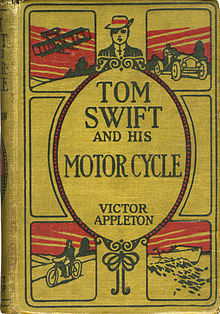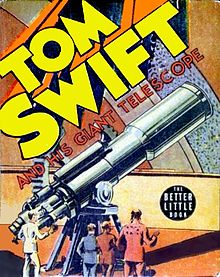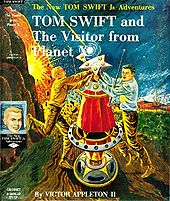Series
Wikisource has original text related to this article:
Tom Swift
The longest-running series of books to feature Tom Swift is the first, which consists of 40 volumes. Tom's son (Tom Swift Jr.) was also the name of the protagonist of the 33 volumes of the Tom Swift Jr. Adventures, the 11 volumes of the third Tom Swift series, the 13 volumes of the fourth, and a half-dozen more for the most recent series, Tom Swift, Young Inventor, for a total of 103 volumes for all the series. In addition to publication in the United States, Tom Swift books have been published extensively in England, and translated into Norwegian, French, Icelandic, and Finnish.
Original series (1910–1941)
"All right, Dad. Go ahead, laugh."
"Well, Tom, I'm not exactly laughing at you ... it's more at the idea than anything else. The idea of talking over a wire and, at the same time, having light waves, as well as electrical waves passing over the same conductors!"
"All right, Dad. Go ahead and laugh. I don't mind," said Tom, good-naturedly. "Folks laughed at Bell, when he said he could send a human voice over a copper string ..."
— Tom Swift and His Photo Telephone (1912)
In the original series, Tom Swift lives in fictional Shopton, New York. He is the son of Barton Swift, the founder of the Swift Construction Company. Tom's mother is deceased, but the housekeeper, Mrs. Baggert, functions as a surrogate mother. Tom usually shares his adventures with close friend Ned Newton, who eventually becomes the Swift Construction Company's financial manager. For most of the series, Tom dates Mary Nestor. It has been suggested that his eventual marriage to Mary led to the series' demise, as young boys found a married man harder to identify with than a young, single one; however, after the 1929 marriage the series continued for 12 more years and eight further volumes. Regularly appearing characters include Wakefield Damon, an older man, whose dialogue is characterized by frequent use of such whimsical expressions as "Bless my brakeshoes!" and "Bless my vest buttons!"
The original Tom Swift has been claimed to represent the early 20th-century conception of inventors. Tom has no formal education after high school; according to critic Robert Von der Osten, Tom's ability to invent is presented as "somehow innate". Tom is not a theorist but a tinkerer and, later, an experimenter who, with his research team, finds practical applications for others' research; Tom does not so much methodically develop and perfect inventions as find them by trial and error.
Tom's inventions are not at first innovative. In the first two books of the series, he fixes a motorcycle and a boat, and in the third book he develops an airship, but only with the help of a balloonist. Tom is also at times unsure of himself, asking his elders for help; as Von der Osten puts it, "the early Tom Swift is more dependent on his father and other adults at first and is much more hesitant in his actions. When his airship bangs into a tower, Tom is uncharacteristically nonplussed and needs support." However, as the series progresses, Tom's inventions "show an increasingly independent genius as he develops devices, such as an electric rifle and a photo telephone, further removed from the scientific norm". Some of Tom's inventions are improvements of then-current technologies, while other inventions were not in development at the time the books were published, but have since been developed.
Second series (1954–1971)
"Did you have time to learn anything?" Bud asked the young inventor.
Tom shrugged. "A little. I was using my new gadget as a wave trap or antenna to capture light of a single wave length from certain stars so I could study their red shift."
From Tom Swift and His Polar-Ray Dynasphere (1965).
In this series, presented as an extension and continuation of the first, the Tom Swift of the original series is now the CEO of Swift Enterprises, a four-mile-square enclosed facility where inventions are conceived and manufactured. Tom's son, Tom Swift Jr., is now the primary inventive genius of the family. Stratemeyer Syndicate employee Andrew Svenson described the new series as based "on scientific fact and probability, whereas the old Toms were in the main adventure stories mixed with pseudo-science". Three PhDs in science were hired as consultants to the series to ensure scientific accuracy. The younger Tom does not tinker with motorcycles; his inventions and adventures extend from deep within the Earth (in Tom Swift and His Atomic Earth Blaster [1954]) to the bottom of the ocean (in Tom Swift and His Diving Seacopter [1956]) to the Moon (in Tom Swift in the Race to the Moon [1958]) and, eventually, the outer Solar System (in Tom Swift and His Cosmotron Express [1970]). Later volumes of the series increasingly emphasized the extraterrestrial "space friends", as they are termed throughout the series. The beings appear as early as the first volume of the series, Tom Swift and His Flying Lab (1954). The Tom Swift Jr., Adventures were less commercially successful than the first series, selling 6 million copies total, compared with sales of 14 million copies for the first series.
In contrast to the earlier series, many of Tom Jr.'s inventions are designed to operate in space, and his "genius is unequivocally original as he constructs nuclear-powered flying labs, establishes outposts in space, or designs ways to sail in space on cosmic rays". Unlike his father, Tom Jr. is not just a tinkerer; he relies on scientific and mathematical theories, and, according to critic Robert Von der Osten, "science [in the books] is, in fact, understood to be a set of theories that are developed based on experimentation and scientific discussion. Rather than being opposed to technological advances, such a theoretical understanding becomes essential to invention."
Tom Swift Jr.'s Cold War-era adventures and inventions are often motivated by patriotism, as Tom repeatedly defeats the evil agents of the fictional nations "Kranjovia" and "Brungaria", the latter a place that critic Francis Molson describes as "a vaguely Eastern European country, which is strongly opposed to the Swifts and the U.S. Hence, the Swifts' opposition to and competition with the Brungarians is both personal and patriotic."
Third series (1981–1984)
The third Tom Swift series differs from the first two in that the setting is primarily outer space, although Swift Enterprises (located now in New Mexico) is occasionally mentioned. Tom Swift explores the universe in the starship Exedra, using a faster-than-light drive he has reverse-engineered from an alien space probe. He is aided by Benjamin Franklin Walking Eagle, a Native American who is Tom's co-pilot, best friend, and an expert computer technician, and Anita Thorwald, a former rival of Tom's who now works with him as a technician and whose right leg has been rebuilt to contain a miniature computer.
This series maintains only an occasional and vague continuity with the two previous series. Tom is called the son of "the great Tom Swift" and said to be "already an important and active contributor to the family business, the giant multimillion-dollar scientific-industrial complex known as Swift Enterprises". However, as critic Francis Molson indicates, it is not explained whether this Tom Swift is the grandson of the famous Tom Swift of the first series or still the Tom Swift Jr. of the second.
The Tom Swift of this third series is less of an inventor than his predecessors, and his inventions are rarely the main feature of the plot. Still, according to Molson, "Tom the inventor is not ignored. Perhaps the most impressive of his inventions and the one essential to the series as a whole is the robot he designs and builds, Aristotle, which becomes a winning and likeable character in its own right." The books are slower-paced than the Tom Swift Jr. adventures of the second series, and include realistic, colloquial dialogue. Each volume begins where the last one ended, and the technology is plausible and accurate.
Fourth series (1991–1993)
The fourth series featuring Tom Swift (again a "Jr.") is set mostly on Earth (with occasional voyages to the Moon); Swift Enterprises is now located in California. In the first book, The Black Dragon, it's mentioned that Tom is the son of Tom Swift Sr. and Mary Nestor. The books deal with what Richard Pyle describes as "modern and futuristic concepts" and, as in the third series, feature an ethnically diverse cast of characters.
Like the Tom Swift Jr. series, the series portrays Tom as a scientist as well as an inventor whose inventions depend on a knowledge of theory. The series differs from previous versions of the character, however, in that Tom's inventive genius is portrayed as problematic and sometimes dangerous. As Robert Von der Osten argues, Tom's inventions for this series often have unexpected and negative repercussions.
a device to create a miniature black hole which casts him into an alternative universe; a device that trains muscles but also distorts the mind of the user; and a genetic process which, combined with the effect of his black hole, results in a terrifying devolution. Genius here begins to recapitulate earlier myths of the mad scientist whose technological and scientific ambitions are so out of harmony with nature and contemporary science that the results are usually unfortunate.
The series features more violence than previous series; in The Negative Zone, Tom blows up a motel room to escape the authorities.
There was a derivative of this series featuring Tom Swift and the Hardy Boys called A Hardy Boys & Tom Swift Ultra Thriller that was published from 1992 to 1993, and only had 2 volumes released. Both books dealt with science fictional topics (time travel and aliens landing on earth).
Fifth series (2006–2007)
The fifth series, Tom Swift, Young Inventor, returns Tom Swift to Shopton, New York, with Tom as the son of Tom Swift and Mary Nestor, the names of characters of the original Tom Swift series. The series features inventions that are close to current technology "rather than ultra-futuristic". In several of the books, Tom's antagonist is The Road Back (TRB), an anti-technology terrorist organization. Tom's personal nemesis is Andy Foger, teenage son of his father's former business partner who now owns a competing (and ethically dubious) high-technology company.
Sixth series (2019-2022)
A sixth series, Tom Swift Inventors' Academy, published by Simon and Schuster, debuted in July 2019 with #1 The Drone Pursuit and #2 The Sonic Breach. A total of eight books were published, concluding with #8 Depth Perception in March 2022.


